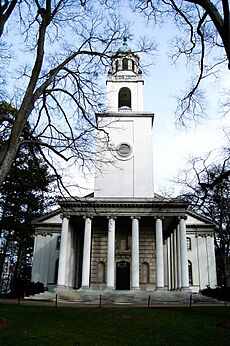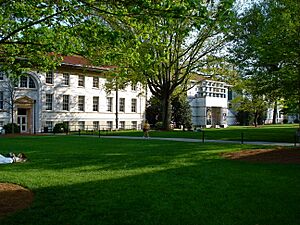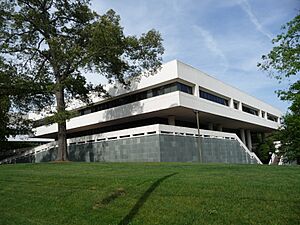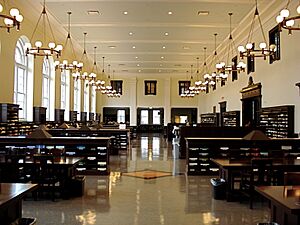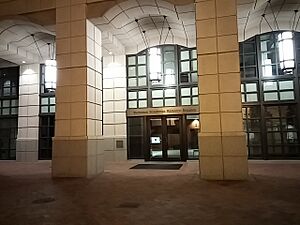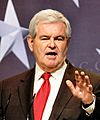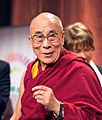Emory University facts for kids
 |
|
|
Former name
|
Emory College (1836–1915) |
|---|---|
| Motto | Cor prudentis possidebit scientiam (Latin) |
|
Motto in English
|
"The wise heart seeks knowledge" |
| Type | Private research university |
| Established | 1836 |
| Accreditation | SACS |
|
Religious affiliation
|
United Methodist Church |
|
Academic affiliations
|
|
| Endowment | $11.044 billion (2024) |
| President | Gregory L. Fenves |
|
Total staff
|
32,594 (2020) includes approx. 24,000 health care employees |
| Students | 15,909 (fall 2022) |
| Undergraduates | 8,155 (fall 2022) |
| Postgraduates | 7,754 (fall 2022) |
| Location |
,
,
United States
33°47′28″N 84°19′24″W / 33.79111°N 84.32333°W |
| Campus | Large city, 631 acres (255 ha) |
| Other campuses |
|
| Newspaper | The Emory Wheel |
| Colors | Blue and gold |
| Nickname | Eagles |
|
Sporting affiliations
|
NCAA Division III – UAA |
| Mascot |
|
 |
|
Emory University is a private university in Atlanta, Georgia, where students can do in-depth research. It was started in 1836 by the Methodist Episcopal Church as Emory College. The school was named after Methodist bishop John Emory. Its main campus is in a neighborhood called Druid Hills, about four miles from downtown Atlanta.
Emory has nine different schools for undergraduate, graduate, and professional studies. These include schools for arts and sciences, business, nursing, medicine, and law. Almost 16,000 students from all over the U.S. and more than 100 other countries attend Emory.
The university is also known for Emory Healthcare, the biggest healthcare system in Georgia. It includes seven large hospitals, like Emory University Hospital. Emory runs major research centers for cancer, vaccines, and other diseases. It is located right next to the U.S. Centers for Disease Control and Prevention (CDC) and works with them on many health projects.
Many important people have studied or taught at Emory. These include a Vice President of the United States, two Prime Ministers, and two Nobel Peace Prize winners.
Contents
History
The 1800s: Beginnings and the Civil War
Emory College was founded in 1836 in Oxford, Georgia, by the Methodist Church. When the American Civil War started in 1861, the college closed. All of its students joined the Confederate army. The college buildings were used as a hospital and later as a headquarters for the Union Army. Thirty-five Emory students died in the war, and much of the campus was damaged.
After the war, Emory College struggled with debt. In 1880, the college president, Atticus Greene Haygood, gave a speech about the end of slavery that impressed a New York banker named George I. Seney. Mr. Seney gave the college money to pay its debts and build new buildings. In the 1880s, a professor named Isaac Stiles Hopkins started a technology department. He later became the first president of the Georgia Institute of Technology.
The 1900s: Moving to Atlanta and Growing

In 1915, Emory College moved to the Atlanta area and became Emory University. This move was possible because of a large land donation from Asa Griggs Candler, the founder of The Coca-Cola Company. Because of large donations from the Candler family and other families connected to Coca-Cola, Emory is sometimes called "Coca-Cola University."
World Wars and Global Impact
During World War I and World War II, Emory organized a medical unit of doctors and nurses who served in Europe. The university also helped train officers for the U.S. Navy and Army. Many Emory students and faculty served in the wars. One graduate, Kiyoshi Tanimoto, was a survivor of the atomic bomb in Hiroshima. He helped organize a program to bring young women injured by the bomb to the U.S. for surgery.
Fighting for Equal Rights
The 1950s and 1960s were a time of big changes. Emory, which had been a school only for men, started admitting women in 1953. During the civil rights movement, Emory challenged a Georgia law that prevented private universities from being tax-exempt if they had students of different races. Emory won the case in the Georgia Supreme Court and officially began admitting students of all races. In 1967, Marvin S. Arrington Sr. became the first full-time African American student to graduate from Emory's law school.
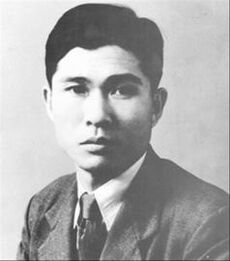
The university also supported human rights around the world. In 1983, Kim Dae-jung, a political leader from South Korea, gave a speech about democracy at Emory. He later became the president of his country and won the Nobel Peace Prize.
Modern Growth
In 1979, Emory received a historic gift of $105 million in Coca-Cola stock from Robert Winship Woodruff and his brother George. At the time, it was the largest single donation ever given to a university in the United States. This gift helped Emory grow into a major research university.
The 21st Century
In recent years, Emory has added new buildings for cancer research, science, and the performing arts. In 2018, the campus officially became part of the city of Atlanta.
In 2024, protests related to the war in Gaza took place on campus, as they did at many other universities. During one protest, police detained two professors, which led to disagreements between some faculty members and the university's president.
What You Can Study at Emory
Admissions
| Admissions statistics | |
|---|---|
|
2021 entering
class |
|
| Admit rate | 10.6% |
| Test scores middle 50% | |
| SAT Total | 1470–1540 |
| ACT Composite | 34–35 |
Getting into Emory is very competitive. For the class that started in 2022, the university received over 33,000 applications and accepted about 11% of them. Students who enroll at Emory have very high test scores and grades.
Undergraduate Schools
Emory College of Arts and Sciences
This is the main undergraduate school at Emory. Students can earn a Bachelor of Arts (B.A.) or a Bachelor of Science (B.S.) degree in many different subjects. The college also offers special honors programs for students who want an extra challenge.
Emory also has a partnership with the Georgia Institute of Technology. Students can earn a degree from both Emory and Georgia Tech in five years through a special engineering program.
Oxford College
Oxford College is a special part of Emory located on the university's original campus in Oxford, Georgia. Students spend their first two years there in a smaller, close-knit community. After finishing at Oxford, they move to the main Atlanta campus to complete their degrees.
| School | Year founded |
|---|---|
| Emory College of Arts and Sciences | 1836 |
| Oxford College | 1836 |
| Emory University School of Medicine | 1854 |
| Nell Hodgson Woodruff School of Nursing | 1905 |
| Candler School of Theology | 1914 |
| Emory University School of Law | 1916 |
| Laney Graduate School | 1919 |
| Goizueta Business School | 1919 |
| Rollins School of Public Health | 1990 |
Graduate and Professional Schools
Emory has several schools for students who have already completed their bachelor's degree.
- School of Medicine: Trains doctors and other medical professionals.
- Nell Hodgson Woodruff School of Nursing: Offers degrees for nurses at all levels.
- Candler School of Theology: A school for training ministers, connected to the Methodist Church.
- School of Law: One of the top law schools in the country.
- Laney Graduate School: Offers Ph.D. and master's degrees in many subjects.
- Goizueta Business School: A top-ranked school for business degrees.
- Rollins School of Public Health: Focuses on improving community health and preventing diseases.
Library System
Emory's library system has over 3.9 million books and electronic items. The Rose Library holds special collections of rare books and papers from famous writers like Flannery O'Connor, Alice Walker, and Salman Rushdie. In 2012, The Princeton Review ranked Emory's libraries as among the 10 best in the country.
Research at Emory
Emory is a top-tier research university, meaning it is a major center for discovery and innovation. In 2021, it received almost $900 million for research from government agencies and other groups.
Emory works closely with the U.S. Centers for Disease Control and Prevention (CDC), which is located right next to the campus. They partner on projects to fight diseases and improve public health around the world. For example, Emory's hospital has a special isolation unit built by the CDC. This unit was used to treat patients during the 2014 Ebola outbreak.
Researchers at Emory are leaders in many fields. The Emory Vaccine Center is one of the largest in the world and is working to develop a vaccine for HIV. Emory scientists also discovered Emtricitabine, a key drug used to treat HIV. The World Health Organization considers it one of the most important antiviral drugs in the world.
Campus Life
Emory has two main campuses. The original campus in Oxford, Georgia, is home to Oxford College. It is a historic site with beautiful old buildings.
The main campus in Atlanta covers over 600 acres in the Druid Hills neighborhood. It has many trees and green spaces. The buildings are known for their granite and Spanish tile designs. The campus is also home to the Michael C. Carlos Museum, which has the largest collection of ancient art in the Southeast.
During the 1996 Summer Olympics in Atlanta, Emory hosted the U.S. Olympic women's gymnastics team. The team, known as the Magnificent Seven, won the first-ever team gold medal for the United States.
Student Life
Student Community
Emory's student body is very diverse. In fall 2024, the university had over 16,000 students. About 60% were female and 40% were male. Students came from all over the United States and many different countries.
Arts and Culture
Students can study dance, theater, music, film, and art. There are also over 50 student clubs for the arts, including groups for breakdancing, poetry, and comedy. The Schwartz Center for Performing Arts hosts concerts and shows for both students and the public.
Community Service
Emory students are active in helping the community. The university has an organization called Volunteer Emory that connects students with service projects. In 2008, Emory received a presidential award for its commitment to community service.
Student Newspaper and Greek Life
The Emory Wheel is the student-run newspaper, which has been publishing since 1919. About 20% of Emory students are also involved in fraternities and sororities.
Sports
Emory's sports teams are called the Eagles. They compete in NCAA Division III as part of the University Athletic Association (UAA). Emory has 18 varsity teams and is often ranked as one of the top schools for its overall athletics program.
Famous People from Emory
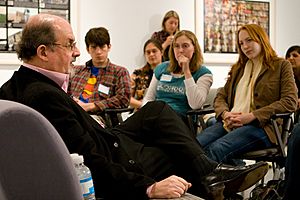
Many well-known people have graduated from or taught at Emory.
- Alben W. Barkley, 35th Vice President of the United States.
- Bobby Jones, a legendary golfer who founded the Masters Tournament.
- Newt Gingrich, former Speaker of the United States House of Representatives.
- Kenneth Cole, a famous clothing designer.
- Jimmy Carter, 39th President of the United States, who is a university professor.
- Desmond Tutu, a Nobel Peace Prize winner from South Africa who was a visiting professor.
- Salman Rushdie, a world-famous author who has taught at Emory.
- Sanjay Gupta, the chief medical correspondent for CNN, who is on the faculty at Emory's medical school.
-
Isaac S. Hopkins, First President of the Georgia Institute of Technology (1859C)
-
Yun Chi-ho, Author of the national anthem of South Korea (1893C)
-
Alben Barkley, 35th Vice President of the United States (1900C, 1949H)
-
Bobby Jones, founder of the Masters Tournament (1929JD)
-
Larry Leon Palmer, United States Ambassador to Barbados and the Eastern Caribbean (1970C)
-
Bernice King, minister and activist, daughter of Martin Luther King Jr. (1990JD)
-
Jim Sarbh, Indian film and stage actor.
-
Robert W. Woodruff, President of The Coca-Cola Company (Did not graduate)
-
Natasha Trethewey, 19th U.S. Poet Laureate and Emory professor.
-
Desmond Tutu, South African activist and Nobel Peace Prize winner (Professor)
-
William Foege, former CDC Director who helped end Smallpox (Professor)
-
Tenzin Gyatso, 14th Dalai Lama, Nobel Peace Prize winner (Professor)
-
Jimmy Carter, 39th President of the United States and Nobel Peace Prize winner (Professor)
See also
 In Spanish: Universidad Emory para niños
In Spanish: Universidad Emory para niños


